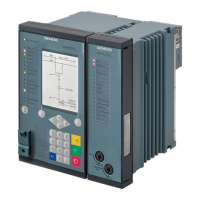Table 3-17 Possible Dropout Values
Signal Type Dropout Values
SP (single-point indication) Outgoing, Incoming, Hold
DP (double-point indication) On, Off, Intermediate Position, Disturbed Position,
Hold
IN (metered values) 0, Hold
MW (measured values) 0, Hold
ACT Hold
NOTE
If the protection link fails, these values can be set on the receiver side.
EXAMPLE
2 devices are connected with differential protection via a 64-kbits channel. This is a type 1 topology. 8 bits are
freely available for priority 1. Now, for example, 4 SPS and 2 DPS can be routed:
4 x 1 bit + 2 x 2 bits = 8 bits
NOTE
Measured values are transmitted as primary values.
Remote Data Transmission: Routing of the Indications and Measured Values to the Protection Interface
The transmission is organized in the form of a data bar which is continuously exchanged between the devices.
For this, see Figure 3-57.
A device indication or measured value is allocated to a definite data area of the bar.
Figure 3-58 to Figure 3-61 show the routing for a communication topology of protection interface type 1.
To transmit signals to other devices, these signals must be routed in the communication matrix under
Transmit. Binary inputs 1 and 2 are single-point indications (SPS) and are routed to position 1 and position 2
of the transmission with the highest priority (priority 1). For 64 kbit/s, for example, only 8 of these data areas
are available for type 1; they are exchanged between the transmission routes with each telegram. Signals 3
and 4 are double-point indications (DPS), for example, a switch position that is transmitted by a device 1. A
double-point indication occupies 2 positions on the data bar. In addition, a measured and metered value are
communicated via priority 3.
As a measured or metered value uses 32 bits, value 2 starts at position 33. DIGSI 5 indicates the next available
position.
System Functions
3.5 Protection Communication
114 SIPROTEC 5, High-Voltage Bay Controller, Manual
C53000-G5040-C015-9, Edition 11.2017

